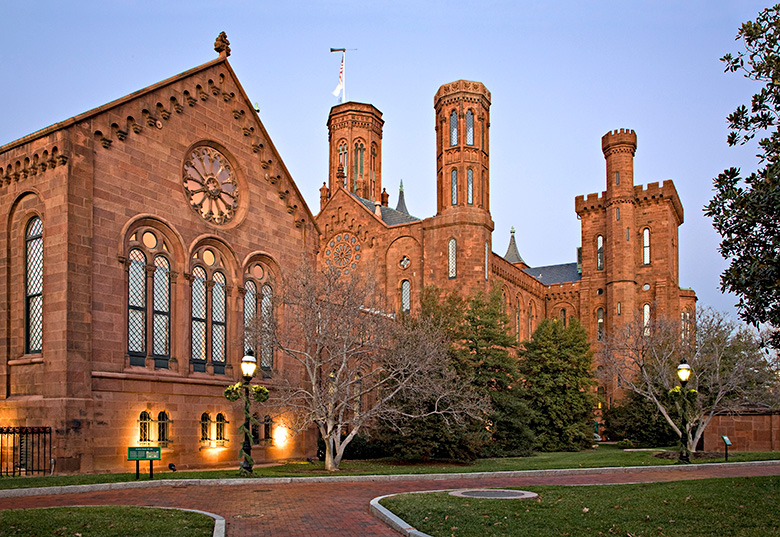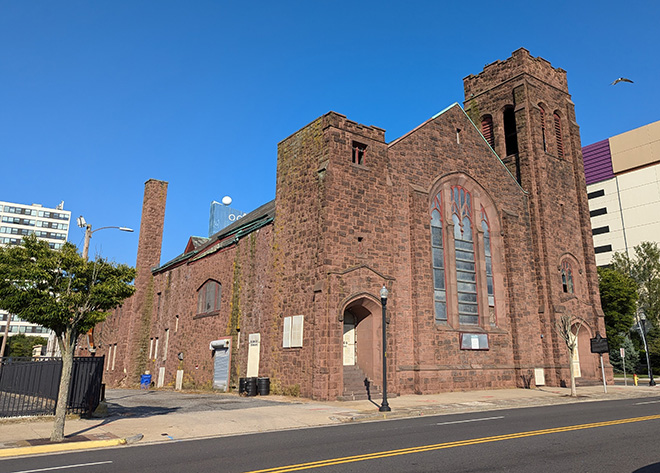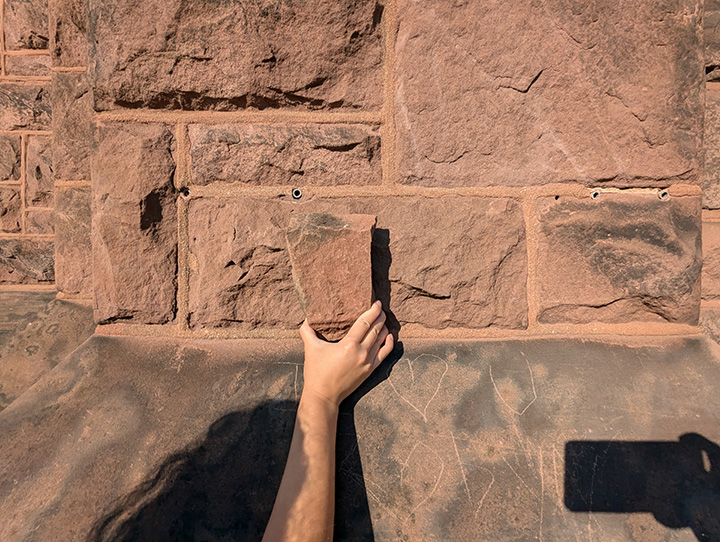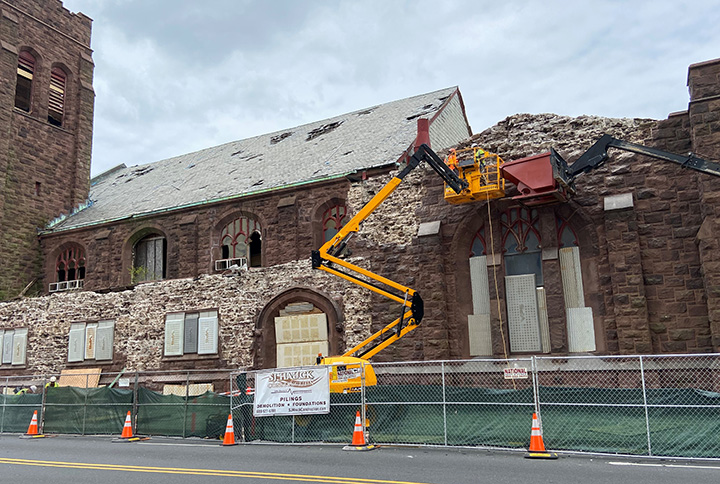Preservation Periodical: Volume 4, Issue 2
Summer 2025
The Role of the Salvaged Stone in Restoring the Smithsonian Castle
By Carly Bond
The Smithsonian Institution is undertaking an unusual project to salvage red sandstone from a historic building slated for demolition, in support of the restoration of the exterior of the Smithsonian Castle. The Revitalize Castle project is currently under construction to be completed in 2030, and will fully restore the building’s exterior and interior. This project is the largest historic preservation undertaking by the Smithsonian Institution and will preserve the Castle for the next 100 years.
Completed in 1855, the Castle is clad in a distinctive stone called Seneca sandstone, which was originally quarried in Seneca, Maryland, located approximately 20 miles from Washington, D.C., near the Potomac River. The Castle’s architect, James Renwick Jr., intended the Castle to be clad in white marble as shown in the original building model and specifications in the Smithsonian’s collections. It is interesting to imagine the Castle in white marble, but it is now nationally recognized for its red stone, which complements the building’s Medieval Revival style architecture. The Seneca quarry closed in 1901 due to the quality of the stone, which diminished as it was quarried.

The Smithsonian has long known about the lack of available Seneca sandstone and has been planning for the Castle restoration for the last 50 years by collecting Seneca from other demolished structures, including the D.C. Jail demolished in 1978. The Castle is a National Historic Landmark and the symbolic heart of the Smithsonian Institution, requiring the highest standards of preservation and in-kind materials for any restoration or replacement. Even with the material in Smithsonian storage, more red sandstone is needed to fully restore the Castle exterior under the current construction project. There could be up to a 30-40% material loss from the salvaged blocks during cutting and dressing for full stone replacements or Dutchman repairs at the Castle.
During the design of the Revitalize Castle project, alternate available stones were considered to supplement the Seneca stockpile. Most red sandstones currently available are sourced from the United Kingdom. Seneca sandstone is characterized by a fine, even grain and consistent color, prized for its ease of carving and exceptional durability. Some options from the United Kingdom matched the Castle’s Seneca aesthetically but did not meet American Society for Testing and Materials standards for absorption and density for classification as sandstone. Alternate sources were considered from China and India, but aside from tariff and cost implications, these sandstones contained striations and swirls that did not match Seneca’s fine, even grain, and were therefore not acceptable alternatives. This left the Smithsonian without a viable sandstone option for this project until First Victory Presbyterian Church.

First Victory Presbyterian Church was built in 1906 in Atlantic City, New Jersey. The church congregation relocated to another building, which was slated for demolition and subsequently sold to a developer. A member of the Revitalize Castle design team from Atlantic City was aware of the situation regarding the Church building and verified the color and aesthetic suitability of the stone for the Castle. Seneca sandstone presents in a range of red colors, from rust to red brown, all found on the Castle. The First Victory sandstone is a reddish brown that matches the brown range of the Seneca sandstone on the Castle. Seneca sandstone originates from a geological formation known as the Newark Supergroup, which extends across several states in a northeast direction from Virginia to New York. Seneca sandstone was quarried from the Culpeper Basin in Maryland, and First Victory’s sandstone likely was quarried from the Newark Basin, all located within the Newark Supergroup.

The Smithsonian reached out to the new building owner of First Victory and took pieces of the Church sandstone to D.C. for material testing and verification that the stone performs the same when cutting and dressing. First Victory’s sandstone performed excellently and matches Seneca’s density and absorption. A contract was entered into to salvage approximately 8,000 cubic feet of sandstone from First Victory for use to restore the Smithsonian Castle. Not all the stone on First Victory is suitable for salvage, as it requires stones of a certain size and depth, because each piece must be cut and dressed to match the Castle’s requirements. There will be salvaged sandstone left after the stone repairs under the Revitalize Castle project are complete, which will be stockpiled to support any future work on the Castle.

Shipments of palleted salvaged stone from First Victory are underway, kept at a Smithsonian storage facility in Maryland. This unusual situation has turned the demolition of a historic building into the long-term preservation of another historic building. Salvaging sandstone from First Victory ensures there is enough red sandstone to restore the Castle and safeguard it for the future.